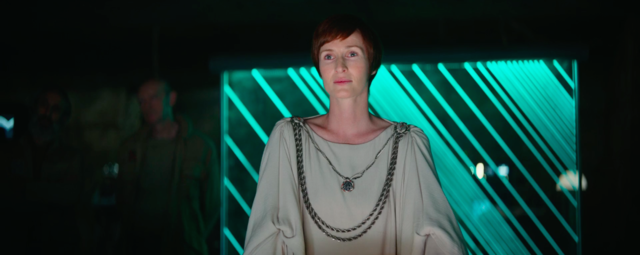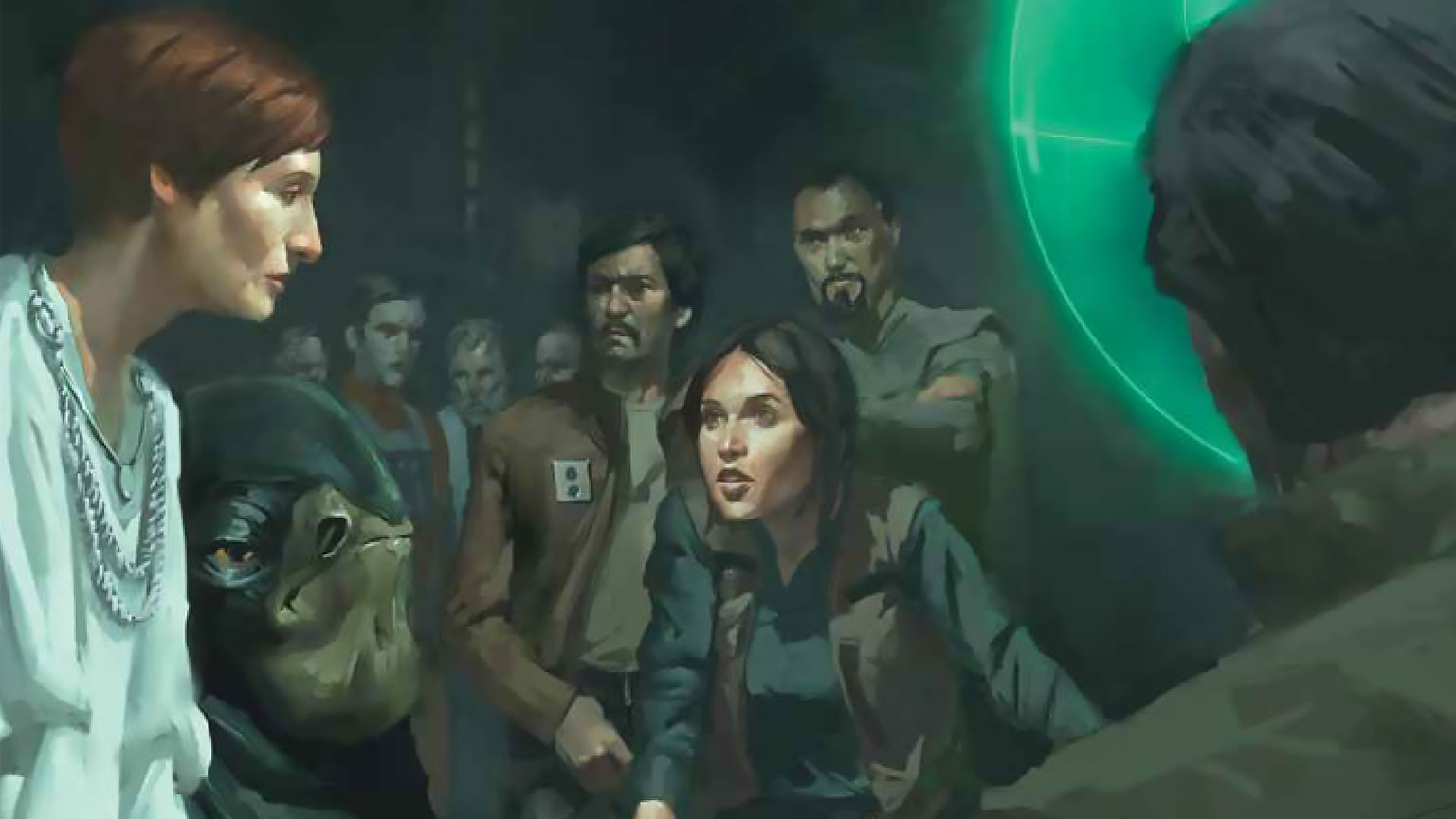
Over a year ago, on this very site, I wrote that I believed it was wrong for Mon Mothma to disband the New Republic armed forces only a year after the Battle of Endor. The Empire, defeated at Jakku, goes in two separate directions: the fleet jumps into hyperspace, hiding in the outskirts of the galaxy, while those remaining sign the Galactic Concordance. The Galactic Concordance states that the Empire may not raise an army, nor can they employ stormtroopers or engage in any weapon building/trafficking. When Starkiller Base fires upon the Hosnian system, the Resistance watches as the New Republic dies in flames. The New Republic, disarmed decades ago under Mothma’s watch, was unable to attend to the growing threat of the First Order, ultimately causing its destruction.
Did Mon Mothma make the right decision? Pragmatically, I still hold that it was wrong to dissolve the New Republic’s military strength. But morally? I think I am siding with her now more than ever. It is hardly up for debate that Mon Mothma has had one of the greatest renaissances of the new canon. Making appearances in Rogue One, and also in comics, novels, and reference books like the recently-released Rebel Files, we’re finally seeing the fuller picture of Mon Mothma that we missed out on when her scenes were cut from Revenge of the Sith. One of the most pressing issues for her, in the canon, is maintaining the integrity of the Alliance and its members while pushing for the end of Palpatine’s tyranny.
While Mothma’s role in many stories has been, essentially, handing out missions or arguing about proposed missions, she has a much more nuanced role in the new canon. She sees violence as a last-ditch effort in the fight to end the Empire’s tyranny, and has problems authorizing violent action on her account unless the full Alliance High Command comes to a unanimous consensus. The Alliance was still a political movement, and it would act and vote accordingly. Her personal views affect the way that she assigns these missions, and they may cause her to deny certain ones.
Mothma had always trusted in the ever-turning wheels of bureaucracy because to her that was a better recourse than violence. This was the case in the Clone Wars, as she fought against adding more clone troopers to the Republic Army, and it was the case even as the Empire grew in strength and oppression. Her hope was to remain in political battles, where people were not changed as negatively as they would be through violent action. When Operation: Fracture was in its infancy, Mothma expressed her disappointment to General Draven over how much violence had been done in the name of the Alliance. She asks, essentially, “if we keep asking people to commit such violence, what will become of them, now or after the war? What will we have created?” Noting especially what Cassian has been tasked to do in the past, she expresses concern for his well-being after how many people he has been tasked with assassinating. If violence leads her soldiers to become like Imperial stormtroopers, there had to be another way.

We see this concern most in her interactions with Leia. After Yavin, Leia pushed Luke, Han, and Chewbacca, with the droids, hard in order to capitalize on the momentum gained in the destruction of the Death Star. Mothma urged Leia to slow down: she can’t overtax her team, and it would be detrimental to both them and the Alliance. Mothma knew that they would already be at a disadvantage as they were seeking a new base, and any military strike would hurt more without a base. Later, before the Battle of Endor, Mothma urged Leia to think about herself, and those she loves, rather than getting caught up in the war machine. Mothma feared that Leia’s relentless drive against the Empire would be fueled more by hatred than by fighting for a galaxy in which she would be free to love. She reminded Leia that she, Leia, was not responsible for the destruction of Alderaan, hoping Leia would ease up and worry about herself for a moment.
I frequently wonder if Mothma tamed Leia’s ambition because she had seen where that drive had pushed Saw Gerrera. Even when handed an opportunity to turn the tide of the war by joining forces with Saw’s Partisans, Mothma refused due to his violent beliefs. Hendri Underholt, Mothma’s attaché, notes how much of the Alliance leadership believes that they can, and should, work with Saw. Major Emmat notes that many of his soldiers worked with Saw at one point. Others in High Command note that he gets results. Mothma absolutely refuses: she will not work with Saw given his high civilian casualty rate. The high casualty rate, as she tells Saw directly before the Jalindi Operation, plus their refusal to follow traditional rules of engagement, means that he operates on the same level as the Empire in her mind. Her Alliance must be better than that, since it seeks to create something better than the Empire.
As Mothma retreated away from Yavin IV, with the imminent threat of a looming Death Star, she pessimistically envisioned a future where the Alliance lost at Yavin, and was essentially destroyed. She believed that a failure of that degree was a direct reflection on her, and that the Alliance, if it continued at all, would have to persist without her. On Yavin, two years prior, Saw accused Mothma of not having the will to fight the Empire and taunted her, saying that he hoped when the Alliance lost, she would be satisfied that they “played by the rules”. Her time racing toward Coruscant was, in a sense, her acceptance that yes, she would indeed be satisfied.

The destruction of the second Death Star finally provided Mothma an opportunity for change without violence. As she was elected Chancellor of the New Republic, the reforms she so desperately sought would come through the political system rather than armed battles. If the New Republic was to thrive under Mon Mothma, it would do so peacefully. She declined to authorize a mission to Kashyyyk when she knew the New Republic Senate would stand against it. She even put a raid on Jakku to a vote when Imperial forces were found in the planet’s orbit. Afterward she put forth her ideas on disarmament to the Senate, hoping to take down about ninety percent of the military and use the remaining ten percent to train local militias. If violence was to be done, it would not be under her orders.
Not only did becoming Chancellor help push forward her dreams of nonviolent galaxy-wide change, it would also be her way of helping purge the galaxy of the evil the violence of the Galactic Civil War had brought on. As the Rebellion was known for taking in former Separatists (Cassian Andor), street thieves (Ezra Bridger), and smugglers (Han Solo), the New Republic could help reform former Imperials. If Mothma believed that even Thrawn would take prisoners, she could trust that Sinjir Rath Velus, a former ISB agent, had good in him and could be reformed. The violence-stricken galaxy might finally have a light at the end of the tunnel of war.
In the end, I was wrong to judge Mon Mothma the way I did a year ago. With the 20/20 vision of hindsight, it was pragmatically the wrong idea. But Mothma is a moral woman of principle, caring about the soul of the person, even if it costs political or military victories. In the end, for her, the disarmament, leaving the New Republic vulnerable to Starkiller Base, was worth it if it meant that the New Republic wouldn’t have hands stained in blood.

The problem isn’t a desire to have a de-armed New Republic, but rather that nothing else was prepared. You noted that she wanted the NR to be focused on helping to establish local militias and the like — that could be very wise. You have one centralized smaller force that works as peacekeepers and a strategic reserve, while local systems/regions have self-defense forces. That can work well.
But that didn’t happen. You ended up having basically one centralized fleet that is easily wiped out, leaving the New Republic open to being thrown under the shackles of tyranny.
This is why the approach was flawed – especially when the New Republic knows that there is another military power out there that has withdrawn. It’s one thing (and quite moral) to say, “We are not going to be about the business of wiping them from the face of the galaxy – we will let them be” – it’s another to act as though they aren’t there and not be prepared to defend yourself – or have your member systems prepared to defend themselves.
How much of that latter aspect falls upon Momtha’s shoulders is unknown – but it’s a ball that got dropped. We can see Leia trying to get that initial dream up and going with the Resistance… but it wasn’t supposed to be just one Resistance, but rather a mutliplicity of local units.
You have one centralized smaller force that works as peacekeepers and a strategic reserve, while local systems/regions have self-defense forces.
What makes you so sure that didn’t happen? The NR home fleet was destroyed, yes, but it’s only been a few days since Hosnian—there could be all manner of sector fleets out there that were scrambling to respond when the FO started their big push in TLJ. Now, it’s a safe bet they were mostly overwhelmed because it seems the movie intends a dominant FO to be the new status quo, but the ST not being interested in showing us some big pitched fight for the overall galaxy doesn’t mean it doesn’t happen.
And anyway, as you suggest yourself—what does or doesn’t happen in the decades after Mothma’s rule (apparently) ended is hardly her fault, let alone the FO pulling a giant fleet out of literally nowhere. It may have been clear that the FO was violating the Concordance and the NR failed to do anything about it but there’s a lot of ground to cover between that and “they can take over the galaxy any day now”—no one knew that.